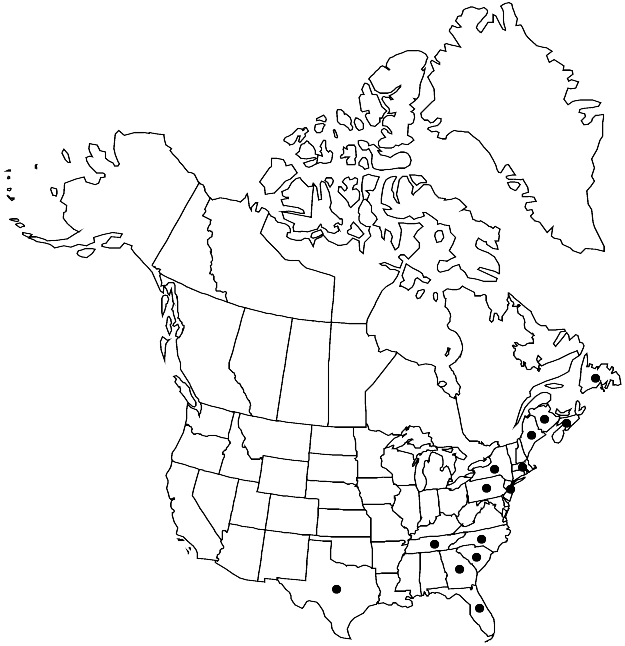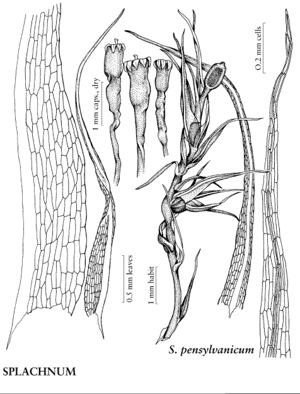Difference between revisions of "Splachnum pensylvanicum"
Bryologist 69: 206. 1966.
FNA>Volume Importer |
imported>Volume Importer |
||
| (3 intermediate revisions by 2 users not shown) | |||
| Line 12: | Line 12: | ||
}}{{Treatment/ID/Special_status | }}{{Treatment/ID/Special_status | ||
|code=F | |code=F | ||
| − | |label= | + | |label=Illustrated |
}} | }} | ||
|basionyms={{Treatment/ID/Basionym | |basionyms={{Treatment/ID/Basionym | ||
|name=Bryum pensylvanicum | |name=Bryum pensylvanicum | ||
|authority=Bridel | |authority=Bridel | ||
| + | |rank=species | ||
|publication_title=Muscol. Recent., suppl. | |publication_title=Muscol. Recent., suppl. | ||
|publication_place=3: 45. 1817 | |publication_place=3: 45. 1817 | ||
| Line 47: | Line 48: | ||
-->{{#Taxon: | -->{{#Taxon: | ||
name=Splachnum pensylvanicum | name=Splachnum pensylvanicum | ||
| − | |||
|authority=(Bridel) Grout ex H. A. Crum | |authority=(Bridel) Grout ex H. A. Crum | ||
|rank=species | |rank=species | ||
| Line 61: | Line 61: | ||
|publication title=Bryologist | |publication title=Bryologist | ||
|publication year=1966 | |publication year=1966 | ||
| − | |special status=Endemic; | + | |special status=Endemic;Illustrated |
| − | |source xml=https:// | + | |source xml=https://bitbucket.org/aafc-mbb/fna-data-curation/src/2e0870ddd59836b60bcf96646a41e87ea5a5943a/coarse_grained_fna_xml/V28/V28_24.xml |
|genus=Splachnum | |genus=Splachnum | ||
|species=Splachnum pensylvanicum | |species=Splachnum pensylvanicum | ||
Latest revision as of 21:34, 5 November 2020
Plants green. Stems 0.2–2.5 cm. Leaves distant throughout, long-lanceolate, 2.5–5 mm; margins usually irregularly and sharply serrate, occasionally entire, indistinctly bordered; apex slenderly long-acuminate; costa disappearing in acumen near apex. Sexual condition autoicous. Seta light green or hyaline, 0.2–1 cm, flexuose. Capsule urn orange-brown, 0.6–0.7 mm; hypophysis greenish, dark red or purplish distally, globose or narrowly pyriform, as wide or slightly wider than urn, wrinkled when dry; operculum conic, bluntly apiculate; exostome teeth inserted below mouth, connate in pairs, brown or orange-brown. Spores subspheric, 7–11 µm, light green.
Phenology: Capsules mature winter–spring.
Habitat: Dung of herbivores (such as moose, cattle)
Elevation: low to moderate elevations
Distribution

N.B., Nfld. and Labr. (Nfld.), N.S., Fla., Ga., Maine, Mass., N.J., N.Y., N.C., Pa., S.C., Tenn., Tex.
Discussion
Splachnum pensylvanicum has a much more southerly distribution than other North American species. The species has often been collected from cattle droppings from Florida through the Atlantic coastal plain north to New England; however, it has become rare within this range. The species is quite abundant on the Avalon Peninsula of eastern Newfoundland, where it grows in both pure and mixed populations with S. ampullaceum on moose droppings. Splachnum pensylvanicum is quite distinct from the other North American species in sporophytic and gametophytic characteristics. Its sporophyte is relatively diminutive, with a very short seta and a small, barely inflated hypophysis. The leaves, like those of S. ampullaceum, are long-lanceolate and slender-acuminate but, unlike the spinose-dentate distal leaf margins of S. ampullaceum, the distal leaf margins of S. pensylvanicum range from entire to irregularly serrate.
